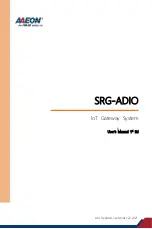
RTCU NX-200 Technical Manual V1.00
Advanced Automotive M2MI/IoT Gateway
Logic IO ApS.
Ph: (+45) 7625 0210
Holmboes Allé 14
Fax: (+45) 7625 0211
8700 Horsens
Page 21 of 45
Email: [email protected]
Denmark
CAN communication port
The RTCU provides the physical layer for the CAN (Controller Area Network) serial
communication interface in accordance with the ISO 11898 standard. The CAN bus is designed for
high-speed (up to 1Mbit) robust communication in especially harsh environments like those found
in the automotive industry.
The CAN interface can be connected to an existing CAN network with a common protocol like the
J1939 standard, to retrieve information for surveillance or information purposes. The interface can
also be used as a robust serial data link with a non-standard protocol. Please consult the RTCU IDE
documentation for more information.
The physical layer consists of a two-wire (CAN-H and CAN-L) differential bus and a signal
ground for reference.
If the RTCU is connected to a “non
-
existing” network, a 120
ohm resistor must be connected
between CAN-H and CAN-L on each end of the transmission line in order to terminate it and
avoid signal reflections. This resistor can be connected by activating the software jumper in the
user application. Please consult the RTCU IDE document for the software jumper for a detailed
description.
Be aware that connecting the RTCU to a CAN network can be dangerous. If the RTCU is not
configured with the correct network parameters, it will lead to network corruption and may
interfere with other connected equipment on the bus. Especially in vehicles, great precautions
must be observed to prevent communication interruptions.
By default, the write capability on the CAN bus channel 1 is disabled. This can be enabled by the
jumper that is located at the front-side of the device.
By default, the write capability on the CAN bus channel 2 is enabled and it is not possible to
disable
A wide range of software functions is available for easy access to the network. Please consult the
RTCU IDE documentation for further information.
X2: 12 pin COM1 connector overview.
Pin
Name
Description
3
CAN1-H
CAN-bus channel 1 H-signal
9
CAN1-L
CAN-bus channel 1 L-signal
8
SGND
Signal Ground
X4: 6 pin COM1 connector overview.
Pin
Name
Description
2
CAN2-H
CAN-bus channel 2 H-signal
3
CAN2-L
CAN-bus channel 2 L-signal
6
SGND
Signal Ground
















































